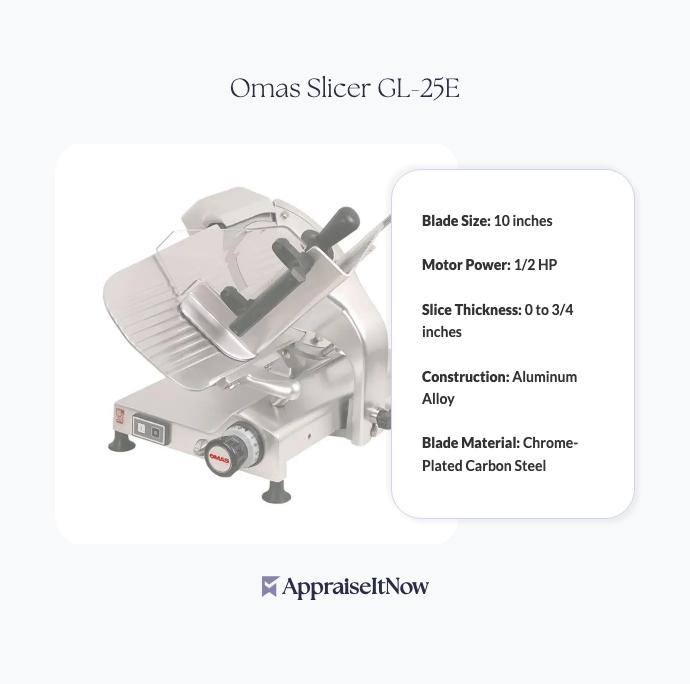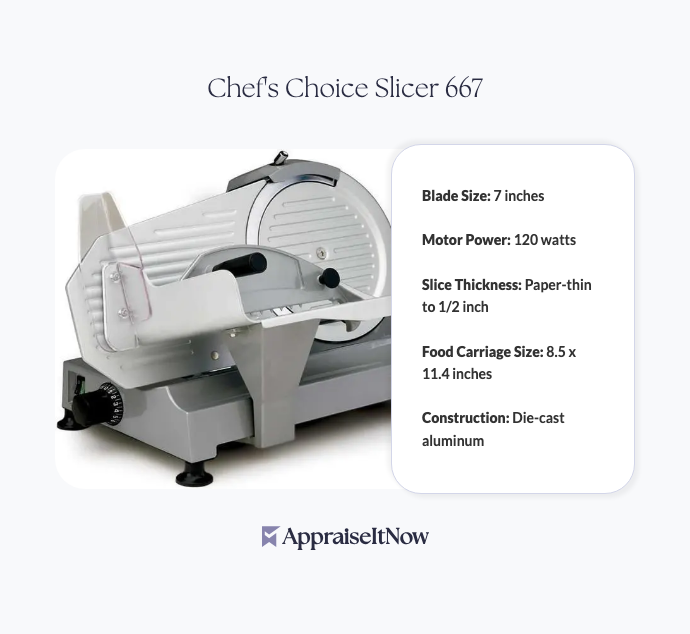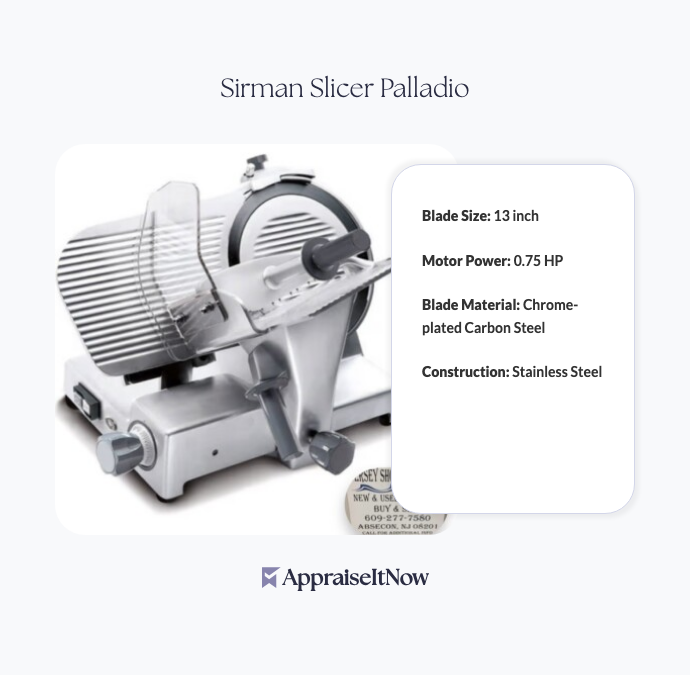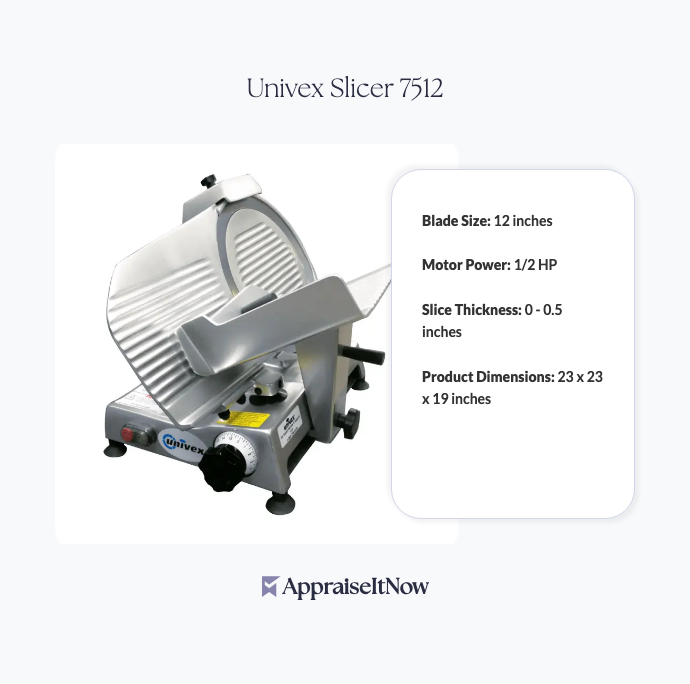<h1>How to Get Your Berkel Red Line Slicer Appraised</h1>
<p>The Berkel Red Line Slicer stands as one of the most sought-after commercial meat slicing machines, commanding market valuations between <strong>$9,000 and $12,000</strong> for quality examples. Whether you're evaluating an inherited piece, planning to sell through a specialty dealer, or securing insurance coverage for your restaurant equipment, understanding the appraisal process ensures you receive accurate documentation that reflects your slicer's true market value.</p>
<h2>Understanding Your Berkel Red Line Slicer's Market Position</h2>
<p>Your Red Line Slicer represents a significant piece of commercial kitchen history. First introduced in 1960 and limited to just <strong>500 units produced worldwide</strong>, this machine earned its reputation through precision engineering and exceptional durability. Crafted from premium stainless steel with a distinctive sapphire crystal gauge cover, the Red Line Slicer continues to attract collectors, culinary professionals, and <a href="/types/restaurant-equipment">restaurant equipment</a> specialists who recognize its superior construction and performance.</p>
<p>The current market demand for Berkel Red Line slicers remains consistently strong. These machines appear regularly at specialty auctions, through restaurant equipment resellers, and on platforms like eBay, though prices vary significantly based on condition and documentation. Understanding where comparable sales occur helps position your slicer appropriately when working with professional appraisers who track these market dynamics.</p>
<div class="callout tip"><p><strong>Market Insight</strong></p>
<p>Berkel slicers with documented service history and original accessories command 15-25% premiums over machines without supporting documentation.</p></div>
<h2>Key Specifications That Influence Appraisal Value</h2>
<p>When professional appraisers evaluate your Berkel Red Line Slicer, they examine several technical features that directly impact valuation. Your machine features a powerful <strong>1/2 HP motor</strong> capable of delivering consistent performance through extended use, paired with a precision-ground, angled slicing blade engineered for exceptional cutting accuracy. The adjustable slice thickness up to 1 inch accommodates everything from paper-thin prosciutto to substantial cheese portions, making it versatile across commercial applications.</p>
<p>The <strong>NSF-certified commercial grade construction</strong> represents another critical value driver. This certification confirms your slicer meets food safety standards, distinguishing genuine Berkel Red Line machines from inferior imitators or stripped variants. Appraisers verify this certification status as part of their evaluation, as NSF compliance significantly affects both functional value and legal compliance for restaurant operations or institutional use.</p>
<p>Understanding these technical specifications helps you communicate effectively with appraisers. Unlike newer slicers with electronic components requiring frequent servicing, your Red Line Slicer's mechanical reliability means condition and original parts availability become paramount in value determination. Professional appraisers specializing in <a href="/types/food-processing-equipment">commercial kitchen equipment</a> recognize that a well-maintained Red Line from 1960-1970 often outperforms machines manufactured decades later.</p>
<h2>Factors That Most Strongly Affect Resale Value</h2>
<p>Professional appraisers consider several interrelated factors when determining your Berkel Red Line Slicer's specific value within the <strong>$9,000-$12,000 range</strong>. Machine condition represents the primary driver, with appraisers evaluating blade sharpness, motor functionality, frame integrity, and surface finish. A slicer that slices cleanly without jamming or hesitation commands substantially higher valuations than machines requiring blade replacement or motor service.</p>
<p>Provenance and documentation significantly influence appraisal outcomes. Original purchase records, service history, facility documentation (whether it served in a renowned restaurant, hotel, or butcher shop), and maintenance receipts all enhance value perception. Appraisers source comparable sales through specialized auction houses like Heritage Auctions and Sotheby's, restaurant equipment brokers, and online platforms where transaction data becomes visible. These comparable sales provide the empirical foundation for your appraisal's market value estimate.</p>
<p>The machine's serial number and production verification matter substantially. Berkel maintained manufacturing records spanning decades, and appraisers cross-reference your slicer's serial number against known production batches to confirm authenticity and production year. This verification process parallels how specialists approach <a href="/types/antiques">antique equipment</a> appraisals, where documentation prevents overvaluation of reproductions or misidentified variants.</p>
<div class="callout note"><p><strong>Condition Assessment</strong></p>
<p>Mechanical slicers like the Red Line generally appreciate when maintained in original condition. Professional restoration might reduce collector value compared to preserved original patina, though it enhances operational functionality and food-safety compliance.</p></div>
<h2>Documentation Required for Remote and In-Person Appraisals</h2>
<p>When you contact professional appraisers for your Berkel Red Line Slicer valuation, they'll request specific information and photographs. High-resolution images of the slicer from multiple angles—including close-ups of the brand nameplate, serial number location, blade assembly, motor nameplate, and overall frame condition—help appraisers conduct preliminary assessments. For remote appraisals through platforms like AppraiseItNow, clear photographs showing any unique markings, damage, or restoration work provide the documentation necessary for certified valuations.</p>
<p>Beyond photographs, appraisers seek operational details. Does the blade rotate smoothly without resistance? Does the gauge accurately indicate slice thickness? Are all original safety features intact and functional? These mechanical details directly correlate with valuation, as a fully operational Red Line commands premiums over machines requiring service. Additionally, documentation of current placement (whether still in active use, stored in climate-controlled conditions, or integrated into a collection) affects the appraiser's assessment of preservation and value retention.</p>
<p>For insurance purposes, appraisers often require detailed condition reports noting any previous repairs, replacement parts, or modifications. Original Berkel parts that maintain compatibility and functionality preserve value, while non-original substitutions may reduce valuations. Professional appraisers understand these distinctions and document them thoroughly, creating USPAP-compliant reports suitable for insurance claims, estate purposes, or transaction documentation.</p>
<h2>Serial Number Databases and Authentication</h2>
<p>Berkel maintained comprehensive manufacturing records throughout the Red Line Slicer's production run. Professional appraisers access these databases—sometimes through direct contact with Berkel historical societies, collector networks, or archived documentation—to verify your machine's production year, original specifications, and authenticity. This verification process prevents overvaluation of inferior machines or counterfeit components disguised as authentic Berkel equipment.</p>
<p>Your slicer's serial number typically appears on the base frame or motor housing. Appraisers note this number and cross-reference it against known production batches, confirming that your Red Line genuinely dates to its claimed era. Early production slicers from the 1960s often command higher valuations due to rarity, while machines from the 1970s-1980s represent more accessible collector entries. This temporal hierarchy reflects collector preferences for earliest examples, similar to how <a href="/types/memorabilia-and-collectibles">memorabilia and collectibles</a> valuations reward scarcity and historical proximity.</p>
<h2>Mechanical Condition and Safety Compliance</h2>
<p>Appraisers evaluating commercial food-processing equipment like your Red Line Slicer assess both mechanical condition and food-safety compliance. The electrical components—including the motor, power cord, and any electrical switches—must meet historical standards for the machine's production year. While modern NSF recertification might not be available for vintage equipment, documentation showing the slicer remains mechanically sound and free from electrical hazards supports higher valuations.</p>
<p>The blade assembly represents the most critical mechanical component. Professional appraisers examine blade sharpness, straightness, and any visible damage or repair history. A slicer with its original blade in good condition commands premiums over machines with replaced blades, though safety concerns might necessitate replacement before commercial use. This balance between original condition and functional safety represents a nuance appraisers navigate carefully, documenting their findings in detailed condition reports that address both historical authenticity and practical usability.</p>
<p>Stainless steel frame integrity affects both value and operational safety. Corrosion, dents, warping, or structural damage all reduce valuations proportionally to repair requirements. Unlike <a href="/types/heavy-machinery">heavy machinery</a> where welding and restoration might restore value, commercial kitchen equipment typically sees preservation of original condition as preferable. Appraisers document surface condition precisely, noting any areas of concern that might affect food contact surfaces or structural reliability.</p>
<div class="callout tip"><p><strong>Safety Consideration</strong></p>
<p>Professional appraisers verify that your Red Line Slicer's blade guard and safety interlock mechanisms function properly. Non-functional safety features reduce valuations and create liability concerns for potential buyers or restaurants considering acquisition.</p></div>
<h2>Appraisal Standards and Report Types</h2>
<p>When seeking professional valuation for your Berkel Red Line Slicer, expect certified appraisers to provide <strong>USPAP-compliant</strong> reports meeting standards required by insurance companies, courts, and financial institutions. These comprehensive reports document the appraiser's methodology, comparable sales analysis, current market conditions, and detailed condition assessment, creating defensible valuations appropriate for insurance coverage, estate planning, or litigation purposes.</p>
<p>Insurance companies typically require USPAP-compliant valuations before issuing coverage for high-value equipment. Your appraisal report should specify replacement value (what a similar machine costs to acquire today) and fair market value (what your specific slicer would sell for in current market conditions). For <a href="/types/equipment-and-machinery">equipment and machinery</a> like your Red Line Slicer, professional reports also address depreciation factors, potential restoration costs, and market demand indicators that justify the valuation conclusion.</p>
<p>Specialized appraisal standards for <a href="/types/restaurant-equipment">commercial equipment</a> may incorporate additional considerations beyond standard USPAP requirements. Some appraisers reference the <strong>American Society of Appraisers (ASA)</strong> or <strong>International Society of Appraisers (ISA)</strong> standards specific to equipment valuation, ensuring reports meet professional credentialing requirements. These credentials signal that your appraiser possesses demonstrated expertise in machinery valuation beyond general property assessment.</p>
<h2>Turnaround Times and Fee Structures</h2>
<p>Professional appraisals of commercial food-processing equipment like your Berkel Red Line Slicer typically require 2-3 weeks from initial submission to completed report delivery. Remote appraisals through photograph-based evaluation may complete faster (7-10 days), while in-person inspections requiring appraiser travel might extend timelines depending on geographic location. AppraiseItNow and comparable services maintain streamlined processes where you submit photographs and descriptions securely online, receiving certified valuations from credentialed experts without scheduling complex in-person visits.</p>
<p>Fee structures for equipment appraisals generally range from <strong>$300-$800</strong> depending on complexity, appraiser credentials, and report comprehensiveness. Simpler valuations based on standard comparable sales analysis cost less than complex reports requiring extensive research, authentication verification, or legal defensibility. Appraisers typically quote fees upfront before beginning work, though particularly specialized assessments (such as verifying rare production variants or addressing authenticity concerns) may cost more. Some appraisers charge flat fees while others bill hourly rates typically ranging from $150-$400 per hour depending on specialization and geographic market rates.</p>
<h2>Comparable Sales and Market Research</h2>
<p>Professional appraisers employ multiple channels to source comparable sales data for your Berkel Red Line Slicer valuation. Specialty auction houses focusing on vintage <a href="/types/restaurant-equipment">restaurant equipment</a> and commercial kitchen machinery provide documented transaction histories with hammer prices, buyer's premiums, and condition assessments. Online platforms including eBay's completed listings, specialist restoration sites, and collector forums reveal asking prices, though actual transaction prices sometimes diverge significantly from initial asking amounts.</p>
<p>Restaurant equipment resellers and salvage companies represent another critical data source. These businesses regularly buy, restore, and resell commercial kitchen equipment, maintaining current market pricing knowledge. Appraisers network with these specialists to understand realistic acquisition prices for machines in various conditions. This ground-level market intelligence, combined with historical auction data, creates a comprehensive picture of your slicer's fair market value within the broader commercial kitchen equipment landscape.</p>
<p>Documentation and verification of comparable sales ensures appraisals withstand professional scrutiny. Rather than relying on single data points, professional appraisers identify multiple comparable machines sold within the past 12-24 months, adjusting for condition, location, and unique features. This methodology parallels approaches used in real estate or <a href="/types/business-assets">business asset</a> valuations, where reproducible analysis supports defensible conclusions. Your appraisal report should detail the comparable sales considered, explaining how your specific slicer's characteristics adjust its value relative to comparable market transactions.</p>
<h2>Restoration vs. Original Condition</h2>
<p>One nuanced question appraisers frequently address is whether professional restoration increases or decreases resale value for high-end Berkel slicers. Unlike some <a href="/types/antique-furniture">antique furniture</a> where restoration commands premiums, commercial kitchen equipment exists in a middle ground. Collectors of vintage equipment prize original patina and unmodified specifications, sometimes reducing valuations for machines that have undergone professional restoration. However, functional restoration addressing safety concerns or enabling food-service use might increase practical market value despite slight collector discounts.</p>
<p>Appraisers distinguish between cosmetic restoration (polishing, repainting) and functional restoration (blade replacement, motor servicing, electrical updates). Functional work that maintains original specifications while ensuring safety often doesn't reduce value. Conversely, cosmetic restoration that removes original finish or alters the machine's historical appearance might reduce collector valuations. This distinction becomes important when considering whether restoration work enhances or diminishes your slicer's value, influencing decisions about investing in professional refurbishment before appraisal or sale.</p>
<div class="callout note"><p><strong>Key Takeaway</strong></p>
<p>A certified Berkel Red Line Slicer appraisal provides documentation that protects your investment, ensures accurate insurance coverage, and positions your machine appropriately whether you're buying, selling, or integrating it into a collection. Professional appraisers navigating the complexities of vintage commercial equipment deliver defensible valuations grounded in comparable sales analysis, technical expertise, and USPAP-compliant methodology that insurance companies, courts, and buyers recognize and trust.</p></div>
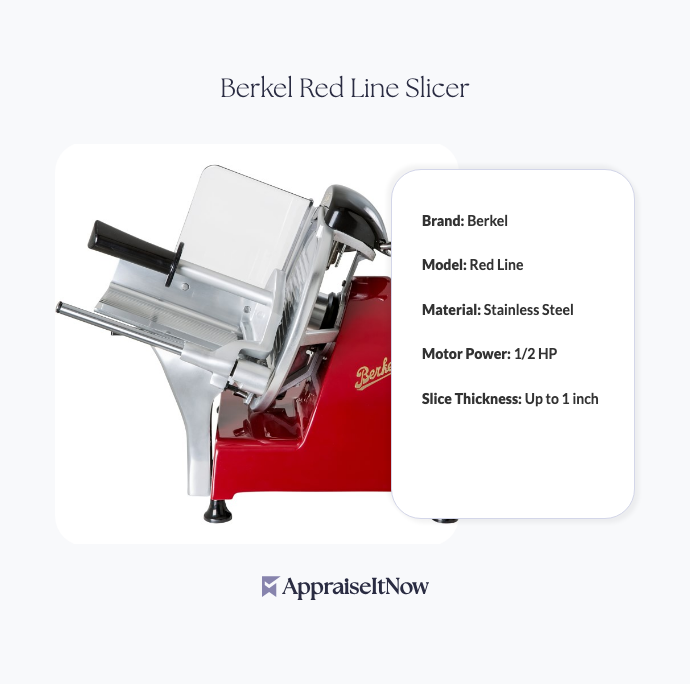






.avif)




